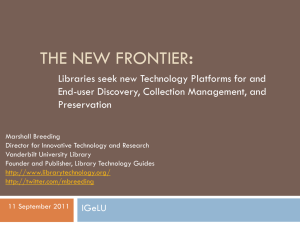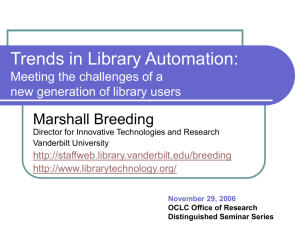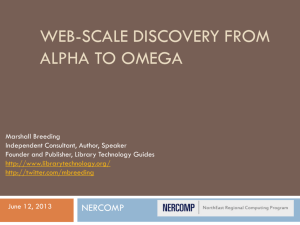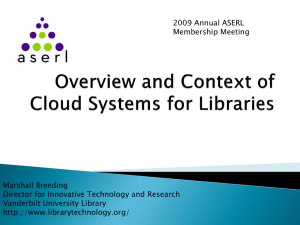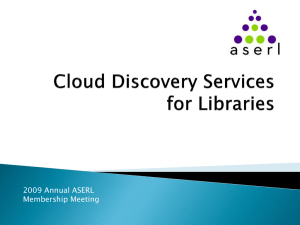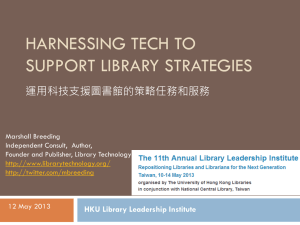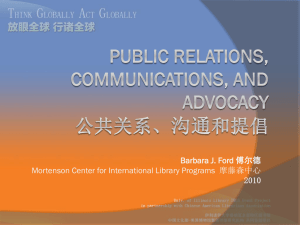Topic 7 New-Generation Library Management
advertisement
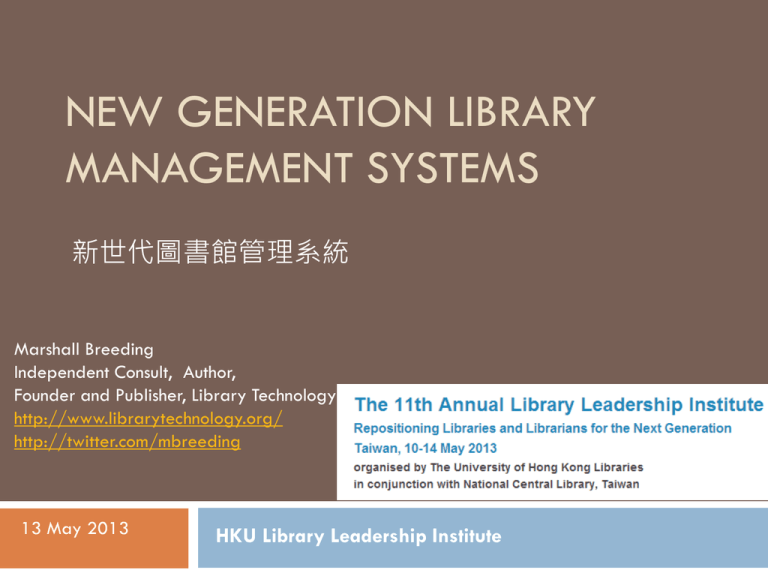
NEW GENERATION LIBRARY MANAGEMENT SYSTEMS 新世代圖書館管理系統 Marshall Breeding Independent Consult, Author, Founder and Publisher, Library Technology Guides http://www.librarytechnology.org/ http://twitter.com/mbreeding 13 May 2013 HKU Library Leadership Institute Challenge: More integrated approach to information and service delivery Library Web sites offer a menu of unconnected silos: Books: Library OPAC (ILS online catalog module) Search the Web site Articles: Aggregated content products, e-journal collections OpenURL linking services E-journal finding aids (Often managed by link resolver) Subject guides (e.g. Springshare LibGuides) Local digital collections ETDs, photos, rich media collections Metasearch engines Discovery Services – often just another choice among many All searched separately Online Catalog ILS Data Search: Scope of Search Search Results Books, Journals, and Media at the Title Level Not in scope: Articles Book Chapters Digital objects Web site content Etc. Next-gen Catalogs or Discovery Interface (2002-2009) Single search box Query tools Did you mean Type-ahead Relevance ranked results (for some content sources) Faceted navigation Enhanced visual displays Cover art Summaries, reviews, Recommendation services Discovery Interface search model Search: Local Index ILS Data Digital Collections ProQuest Search Results Metasearch Engine EBSCOhost … MLA Bibliography ABC-CLIO Real-time query and responses Discovery Products http://www.librarytechnology.org/discovery.pl Differentiation in Discovery Products increasingly specialized between public and academic libraries Public libraries: emphasis on engagement with physical collection + e-books Academic libraries: concern for discovery of heterogeneous material types, especially books + articles + digital objects Discovery from Local to Web-scale Initial products focused on technology AquaBrowser, Endeca, Primo, Encore, VuFind, LIBERO Uno, Civica Sorcer, Axiell Arena Mostly locally-installed software Current phase is focused on pre-populated indexes that aim to deliver Web-scale discovery Primo Central (Ex Libris) Summon (Serials Solutions) WorldCat Local (OCLC) EBSCO Discovery Service (EBSCO) Encore Synergy (no index, though) Public Library Information Portal LMS Data Digital Collections Search: Usagegenerated Data Customer Profile Consolidated Index Search Results Web Site Content Community Information Aggregated Content packages … Customerprovided content Reference Sources Archives Pre-built harvesting and indexing Web-scale Index-based Discovery (2009- present) Digital Collections Search: Consolidated Index Search Results ILS Data Web Site Content Institutional Repositories Aggregated Content packages … E-Journals Reference Sources Pre-built harvesting and indexing Web-scale Search Problem ILS Data Digital Collections Search Results Consolidated Index Search: Web Site Content Institutional Repositories Aggregated Content packages … E-Journals ??? Problem in how to deal with resources not provided to ingest into consolidated index Pre-built harvesting and indexing Non Participating Content Sources Populating Web-scale index with full text Citations or structured metadata provide key data to power search & retrieval and faceted navigation Indexing full text of content amplifies access Every title, phrase, term becomes an access point Important to understand depth indexing Currency, dates covered, full-text or citation Many other factors Full-text Book indexing HathiTrust: 11 million volumes, 5.3 million titles, 263,000 serial titles, 3.5 billion pages HathiTrust in Discovery Indexes Primo Central (Jan 20, 2012) [previously indexed only metadata] EBSCO Discovery Service (Sept 8 2011) WorldCat Local (Sept 7, 2011) Summon (Mar 28, 2011) Challenge for Relevancy Technically feasible to index hundreds of millions or billions of records through Lucene or SOLR Difficult to order records in ways that make sense Many fairly equivalent candidates returned for any given query Must rely on use-based and social factors to improve relevancy rankings Challenges for Collection Coverage To work effectively, discovery services need to cover comprehensively the body of content represented in library collections What about publishers that do not participate? Is content indexed at the citation or full-text level? What are the restrictions for non-authenticated users? How can libraries understand the differences in coverage among competing services? Evaluating Index-based Discovery Services Intense competition: how well the index covers the body of scholarly content stands as a key differentiator Difficult to evaluate based on numbers of items indexed alone. Important to ascertain now your library’s content packages are represented by the discovery service. Important to know what items are indexed by citation and which are full text Important to know whether the discovery service favors the content of any given publisher Open Discovery Initiative NISO Work Group to Develop Standards and Recommended Practices for Library Discovery Services Based on Indexed Search Informal meeting called at ALA Annual 2011 Co-Chaired by Marshall Breeding and Jenny Walker Term: Dec 2011 – May 2013 Balance of Constituents 18 Libraries Marshall Breeding, Vanderbilt University Jamene Brooks-Kieffer, Kansas State University Laura Morse, Harvard University Ken Varnum, University of Michigan Sara Brownmiller, University of Oregon Lucy Harrison, College Center for Library Automation (D2D liaison/observer) Michele Newberry Publishers Lettie Conrad, SAGE Publications Beth LaPensee, ITHAKA/JSTOR/Portico Jeff Lang, Thomson Reuters Linda Beebe, American Psychological Assoc Aaron Wood, Alexander Street Press Service Providers Jenny Walker, Ex Libris Group John Law, Serials Solutions Michael Gorrell, EBSCO Information Services David Lindahl, University of Rochester (XC) Jeff Penka, OCLC (D2D liaison/observer) ODI Project Goals: Identify … needs and requirements of the three stakeholder groups in this area of work. Create recommendations and tools to streamline the process by which information providers, discovery service providers, and librarians work together to better serve libraries and their users. Provide effective means for librarians to assess the level of participation by information providers in discovery services, to evaluate the breadth and depth of content indexed and the degree to which this content is made available to the user. Timeline 20 Milestone Target Date Appointment of working group December 2011 Approval of charge and initial work plan March 2012 Agreement on process and tools June 2012 Completion of information gathering October 2012 Completion of initial draft January 2013 Completion of final draft May 2013 ODI Survey: www.surveymonkey.com/s/QBXZXSB Status The rise of e-books Academic libraries: e-books included in aggregated content packages E-books used primarily for research and consultation, not long reading Public Libraries: Subscriptions to e-book services that provide an outsourced collection of loanable ebooks K-12 Schools, Colleges, Universities: interest in electronic textbooks Integrating e-Books into Library Automation Infrastructure Current approach involves mostly outsourced arrangements Collections licensed wholesale from single provider Hand-off to DRM and delivery systems of providers Loading of MARC records into local catalog with linking mechanisms No ability to see availability status of e-books from the library’s online catalog or discovery interface 2013: The current state of discovery Online Catalogs of ILS modules in decline Increasing numbers of academic libraries offer discovery services Index-based search emerges Summon, Primo/Primo Central, EBSCO Discovery Service, WorldCat Local Indexes growing in comprehensiveness and depth. Relevancy algorithms gaining sophistication Increasing numbers of publishers and providers cooperate with library discovery services Open Discovery Initiative launched October 2011 New-generation Library Management Fragmented Library Management LMS for management of (mostly) print Duplicative financial systems between library and local government or other parent organization E-book lending platform (multiple?) Interlibrary loan (borrowing and lending) Self-service and AMH infrastructure Electronic Resource Management PC Scheduling and print management Event scheduling Digital Collections Management platforms (CONTENTdm, DigiTool, etc.) Discovery-layer services for broader access to library collections No effective integration services / interoperability among disconnected systems, non-aligned metadata schemes Is the status quo sustainable? ILS for management of (mostly) print Duplicative financial systems between library and campus Electronic Resource Management (non-integrated with ILS) OpenURL Link Resolver w/ knowledge base for access to full-text electronic articles Digital Collections Management platforms (CONTENTdm, DigiTool, etc.) Institutional Repositories (DSpace, Fedora, etc.) Discovery-layer services for broader access to library collections No effective integration services / interoperability among disconnected systems, non-aligned metadata schemes Integrated (for print) Library System Public Interfaces: Staff Interfaces: Interfaces Business Logic Data Stores Circulation BIB Cataloging Holding / Items Circ Transact Acquisitions User Serials Vendor Online Catalog $$$ Funds Policies LMS / ERM: Fragmented Model Staff Interfaces: Public Interfaces: Application Programming Interfaces CirculationCatalogingAcquisitions Serials BIB Online Catalog Protocols: CORE ` Holding Circ $$$ User Vendor Policies / ItemsTransact Funds E-resource License Procurement Management E-Journal Titles Vendors License Terms Common approach for ERM Staff Interfaces: Public Interfaces: Budget License Terms Application Programming Interfaces CirculationCatalogingAcquisitions Serials Online Catalog Titles / Holdings Vendors BIB Holding Circ $$$ User Vendor Policies / ItemsTransact Funds Access Details Gaps in Automation Almost no systematic automation support for references and research services Customer Relationship Management? Resource sharing / Interlibrary loan management Collection development support Comprehensive Resource Management No longer sensible to use different software platforms for managing different types of library materials ILS + ERM + OpenURL Resolver + Digital Asset management, etc. very inefficient model Flexible platform capable of managing multiple type of library materials, multiple metadata formats, with appropriate workflows Support for management of metadata in bulk Continuous lifecycle chain initiated before publication Academic Libraries need a new model of library management Not an Integrated Library System or Library Management System The ILS/LMS was designed to help libraries manage print collections Generally did not evolve to manage electronic collections Other library automation products evolved: Electronic Resource Management Systems – OpenURL Link Resolvers – Digital Library Management Systems -Institutional Repositories Library Services Platform Library-specific software. Designed to help libraries automate their internal operations, manage collections, fulfillment requests, and deliver services Services Service oriented architecture Exposes Web services and other API’s Facilitates the services libraries offer to their users Platform General infrastructure for library automation Consistent with the concept of Platform as a Service Library programmers address the APIs of the platform to extend functionality, create connections with other systems, dynamically interact with data Library Services Platform Characteristics Highly Shared data models Delivered through software as a service Multi-tenant Unified workflows across formats and media Flexible metadata management Knowledgebase architecture Some may take hybrid approach to accommodate local data stores MARC – Dublin Core – VRA – MODS – ONIX Bibframe New structures not yet invented Open APIs for extensibility and interoperability Library Services Platforms Category WorldShare Alma Management Services OCLC. Ex Libris Intota Key precepts Global network-level approach to management and discovery. Consolidate workflows, unified management: print, electronic, digital; Hybrid data model Knowledgeba se driven. Pure multitenant SaaS Software model Proprietary Proprietary Proprietary Responsible Organization Serials Solutions Sierra Services Platform Innovative Interfaces, Inc Kuali OLE Service-oriented architecture Technology uplift for Millennium ILS. More open source components, consolidated modules and workflows Proprietary Manage library resources in a format agnostic approach. Integration into the broader academic enterprise infrastructure Kuali Foundation Open Source Library Services Platforms Category WorldShare Alma Management Services OCLC. Ex Libris Intota Key precepts Global network-level approach to management and discovery. Consolidate workflows, unified management: print, electronic, digital; Hybrid data model Knowledgeba se driven. Pure multitenant SaaS Software model Proprietary Proprietary Proprietary Responsible Organization Serials Solutions Sierra Services Platform Innovative Interfaces, Inc Kuali OLE Service-oriented architecture Technology uplift for Millennium ILS. More open source components, consolidated modules and workflows Proprietary Manage library resources in a format agnostic approach. Integration into the broader academic enterprise infrastructure Kuali Foundation Open Source Development Resources Company Dev Sup Ex Libris Follett Software Company Innovative Interfaces, Inc. SirsiDynix Corporation Serials Solutions Axiell The Library Corporation Polaris Library Systems VTLS Inc. Sales Admin Other Total 170 87 83 84 80 57 39 27 24 231 143 158 166 50 66 91 42 48 54 86 43 51 46 34 28 15 12 44 49 24 23 4 35 13 2 8 13 0 3 56 57 34 28 18 512 365 311 380 237 226 199 86 110 ByWater Solutions Catalyst IT 3 3 12 3 3 1 13 BibLibre 4 3 15 5 16 8 8 6 5 2 3 Koha Koha Total (estimated) PTFS 155 Evergreen Equinox Software 5 21 Open Systems Achieving openness has risen as the key driver behind library technology strategies Libraries need to do more with their data Ability to improve customer experience and operational efficiencies Demand for Interoperability Open source – full access to internal program of the application Open API’s – expose programmatic interfaces to data and functionality Open Source Integrated Library Systems Major thread in library systems development Koha Evergreen Kuali OLE New Library Management Model Unified Presentation Layer Search: Library Services Platform API Layer ` Digital Coll Consolidated index Self-Check / Automated Return ProQuest EBSCO … JSTOR Stock Management Enterprise Resource Planning Learning Management Other Resources Smart Cad / Payment systems Authentication Service Development / Deployment perspective Beginning of a new cycle of transition Over the course of the next decade, academic libraries will replace their current legacy products with new platforms Not just a change of technology but a substantial change in the ways that libraries manage their resources and deliver their services Eventual product consolidation Alma for resource management Eventual transition of Voyager and Aleph Immediate transition of Verde SFX DigiTool for digital collections Primo / Primo Central for Discovery Rosetta for Preservation Possible integration into Alma? Competing Models of Library Automation Traditional Proprietary Commercial ILS Traditional Open Source ILS Aleph, Voyager, Millennium, Symphony, Polaris, BOOK-IT, DDELibra, Libra.se LIBERO, Amlib, Spydus, TOTALS II, Talis Alto, OpenGalaxy Evergreen, Koha New generation Library Services Platforms Ex Libris Alma Kuali OLE (Enterprise, not cloud) OCLC WorldShare Management Services, Serials Solutions Intota Innovative Interfaces Sierra (evolving) Convergence Discovery and Management solutions will increasingly be implemented as matched sets Ex Libris: Primo / Alma Serials Solutions: Summon / Intota OCLC: WorldCat Local / WorldShare Platform Except: Kuali OLE, EBSCO Discovery Service Both depend on an ecosystem of interrelated knowledge bases API’s exposed to mix and match, but efficiencies and synergies are lost Appropriate Automation Infrastructure Current automation products out of step with current realities Increasing proportions of library collection funds spent on electronic content Majority of automation efforts support print activities Management of e-content continues with inadequate supporting infrastructure New discovery solutions help with access to e-content Library users expect more engaging socially aware interfaces for Web and mobile Library Automation in the Cloud Almost all library automation vendors offer some form of “cloud-based” services Server management moves from library to Vendor Subscription-based business model Comprehensive annual subscription payment Offsets local server purchase and maintenance Offsets some local technology support Leveraging the Cloud Moving legacy systems to hosted services provides some savings to individual institutions but does not result in dramatic transformation Globally shared data and metadata models have the potential to achieve new levels of operational efficiencies and more powerful discovery and automation scenarios that improve the position of libraries overall. Development / Deployment perspective Beginning of a new cycle of transition Over the course of the next decade, academic libraries will replace their current legacy products with new platforms Not just a change of technology but a substantial change in the ways that libraries manage their resources and deliver their services Progressive consolidation of library services Centralization of technical infrastructure of multiple libraries within a campus Resource sharing support Direct borrowing among partner institutions Shared infrastructure between institutions Examples: 2CUL (Columbia University / Cornell University) Orbis Cascade Alliance (37 independent colleges and universities to merge into shared LSP) Open source and Open Access Open source development of platform services Open source infrastructure components Open APIs to expose platform services Knowledge base components Open access Community maintained Adequately resourced

